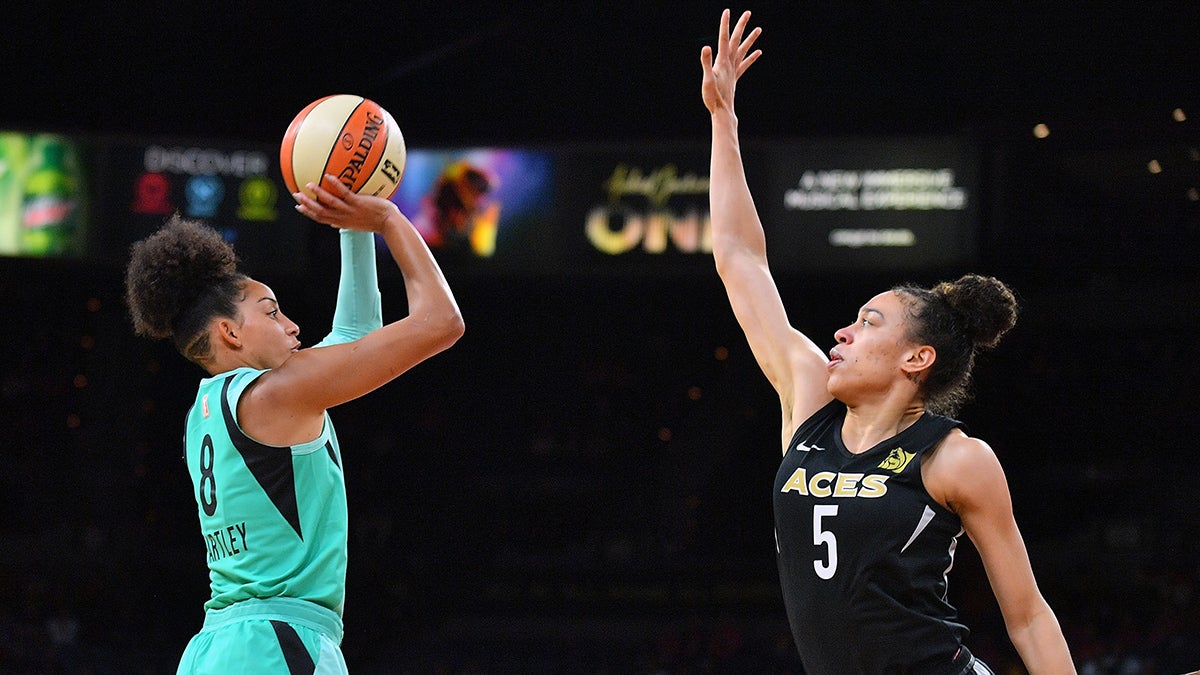Despite new CBA, WNBA salaries and benefits still lag far behind international leagues
Why this matters
Under the new CBA, teams and players will see a massive jump in salary and salary cap, a 53 percent increase in cash compensation, including base salary, bonuses, prize pools and more.
The WNBA made history when it announced the league and Women’s National Basketball Players Association (WNBPA) agreed in principle to a new Collective Bargaining agreement on Jan. 14 and will run through 2027, with major improvements to player pay, travel conditions and maternity leave.
The two parties ratified the previous CBA following the 2014 season to run through the 2021 season. The WNBPA used an opt out after four years of the previous CBA, expiring last October while the two sides engaged in negotiations on a new version.
Under the new CBA, teams and players will see a massive jump in salary and salary cap, a 53 percent increase in cash compensation, including base salary, bonuses, prize pools and more.
The new CBA includes improvements in the following:
Salary/Cash Compensation:
- Top players can now earn over $500,000 in cash compensation (including bonuses/incentives), and between $200,000 and $300,000 in salary, a big bump from the projected $121,500 max salary for the 2021 season. ($121,500 for the 2021 season)
- The CBA also notes that for the first time in WNBA history, the average player compensation will be six figures, around $130,000. The league also set a minimum of $750,000 in prize pool money for special competitions beginning in the 2021 season.
- A new 50-50 revenue sharing agreement, meaning the league will now pay 50% of its revenue to the players like the NBA does (the previous revenue sharing agreement was 25% to the players.)
- Increased bonus for performance awards.
Travel:
- Player travel conditions greatly improve under the new CBA. After years of flying coach, sharing hotel rooms and enduring the pains any ordinary traveler would, WNBA athletes now get premium economy status on flights during the regular season.
- Players will also get individual hotel room accommodations on all road trips.
Family:
- Players will now receive full salary while on maternity leave.
- Annual child care stipend of $5,000.
- Teams will provide two-bedroom apartments for players with children, comfortable workplace conditions for nursing mothers.
- New family planning benefits that include up to $60,000 in reimbursement for veteran players for costs directly related to adoption, surrogacy, oocyte cryopreservation or fertility/infertility treatment.
The league wanted players to view the WNBA as a priority and the premier women’s basketball league. Too often, the WNBA loses players to injury during the offseason while playing overseas to supplement their salary.
2018 WNBA MVP Breanna Stewart lost her entire 2019 season due to a torn achilles while playing for Dynamo Kursk in Russia, and is one of many WNBA players who have suffered injuries while playing in the offseason. Eighty one WNBA players played overseas in the 2018-19 offseason across 13 different countries. The percent of WNBA players that end up playing overseas in the off-season sits at around 75 percent.
Players have long lauded the better conditions overseas than in the U.S. There have been reports of salaries more than triple the amount earned under the former WNBA CBA. Phoenix Mercury star center Brittney Griner reportedly earned $1.5 million in Russia during the 2018-19 season. Her Phoenix teammate, star guard Diana Taurasi, reportedly earned the same amount in the 2015-16 offseason in Russia.
How can these teams afford to pay their players a much higher salary than their American counterparts? According to agent Allison Galer and Newsday, these franchises are funded by a municipal government (most Russian teams do this), a rich owner who appreciates women’s hoops (also mostly in Russia), or in partnership with a high-earning soccer franchise (much like how six WNBA franchises are partnered with corresponding NBA teams in their respective cities).
Besides the pay, the benefits players receive overseas is vastly different from what they receive in the U.S.. ESPN’s Jim Caple detailed the 2006-2007 WNBA offseason of Taurasi and Seattle Storm star Sue Bird with Spartak Moscow. Besides each of them making at least four times their WNBA salaries, the living conditions provided almost reflected that of their NBA counterparts.
Caple wrote: “From December to mid-May, the two former UConn teammates were back together, living in a rent-free, six-bedroom villa only slightly smaller than the Kremlin, so lavish it included an indoor swimming pool and a sauna. They had a part-time cook. They had an interpreter. They had personal drivers. They received three round-trip, business-class flights between the United States and Moscow during the season. They regularly flew business class or charter for road games. They played in a new arena with a photo mural of the team stretching across the entire back wall. von Kalmanovic phoned them several times a day, took them to dinner and shows, and flew them abroad on break.”
Taurasi said it best in a June interview with espnW: “We had to go to a communist country to get paid like capitalists.”
It’s not because Spartak rakes in cash with large crowds and a large TV contract. They didn’t. According to the article, the team averaged about 3,000 fans a game and tickets were free. The team also paid to get its games televised. This would lead to the team having $5-$6 million in expenses each year, with little-to-no revenue, according to owner Shabtai von Kalmanovic.
The owner of the team, the late von Kalmanovic, didn’t care. For him, he said, “Basketball is everything. It’s a hobby, a pleasure, a casino. Whatever you want.”
And that’s how the players view it should be in the U.S., even if it’s not.
TJ Mathewson is a junior sports journalism student at Arizona State University.


